If you’ve ever screamed “TALK TO A HUMAN!” into your phone, you already know this debate isn’t black and white.
On one side, you’ve got AI chatbots that work 24/7, never get tired, and answer instantly.
On the other, you’ve got human agents who understand tone, empathy, and complex questions.
So, which is better?
Let’s break it down. Not just with pros and cons, but by real use cases, context, and outcomes.
AI Chatbot vs. Human: Key Differences Compared
What Chatbots Genuinely Do Better (& When to Use Them)
Here’s why you should use chatbots:
1. Unwavering Availability: Instant Responses, 24/7/365
Chatbots don’t need sleep, holidays, or sick days. So, when a customer in a different time zone needs to know their refund status at 3 a.m., or a prospect has a quick question on Christmas Day, the chatbot is there, ready to engage.
This makes immediate assistance possible at any moment.
2. Flawless Handling of High-Volume, Repetitive Queries
Think about the questions you and your team hear multiple times in a day:
- “Where’s my order? (WISMO)”
- “How do I reset my password?”
- “What are your opening hours?”
- “Can you explain your refund policy?”
These are the types of questions you want to automate.
Freeing up your human agents from answering the same 20–50 questions a day allows them to focus on higher-value, more complex interactions.

3. Dramatically Improves First Response Time (FRT) & Initial Triage
Even if a human ultimately resolves the issue, a chatbot can still be useful:
- It can instantly greet the customer and collect essential initial context (e.g., order number, account ID, nature of the issue), while the human agent gets to them.
- Intelligently route the query to the correct department or specialized agent.
- Set clear expectations regarding wait times or next steps.
This not only slashes your FRT but also significantly boosts CSAT and reduces customer frustration from the outset.
4. Scale Support without Hiring More People
Got more customers or seasonal spikes? Chatbots handle the load instantly. You don’t need to hire, train, or onboard new reps. They reply fast, 24/7, and keep your human team from getting overwhelmed.
5. Keep Answers Consistent and Capture Key Insights
AI Chatbots always give the same correct answers to FAQs. Every chat gets logged, so you can track common issues, find content gaps, and spot product or service problems fast.
How Can Lindy’s AI Chatbots Help Your Business Run Smoother?
Lindy is a no-code tool that lets you build smart AI bots to automate tasks and manage day-to-day work. Here’s how Lindy can help:
1. Handle Customer Support Automatically
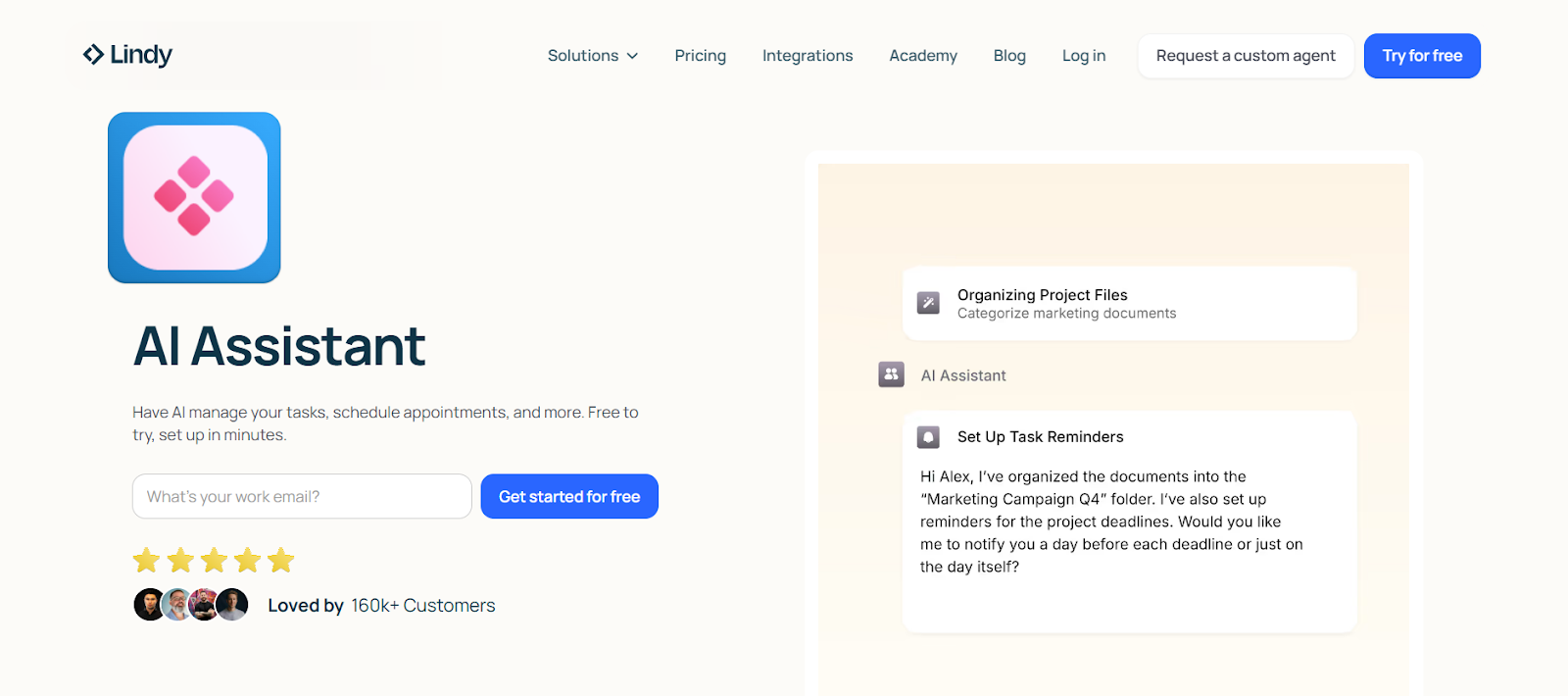
Lindy replies to common questions fast and accurately—24/7. It handles a large volume of messages without breaking a sweat. And when an issue needs human help, it instantly loops in your support team.
2. Clean Up Your Email Inbox
Lindy can write, send, and organize emails for you. It handles replies, follow-ups, and even negotiates deals, which can save you hours. You won’t feel buried in emails anymore.
3. Manage Meetings Without the Chaos
Lindy keeps your calendar in order. It schedules meetings, sends reminders, avoids double-bookings, and connects across tools like Google Calendar, Zoom, and Slack. It can also log your sales meetings in the CRM and remind you of action items.
4. Keep Your Team’s Workflows on Track
Lindy connects with tools like Slack and Freshdesk to keep everyone in sync. It automates boring tasks so your team stays focused and productive. Everything runs smoother because Lindy coordinates across platforms in real time.
{{templates}}
Where Bots Still Struggle (And Risk Frustrating Customers)?
AI is smart, but it’s not perfect. Bots still miss the mark in a few areas.
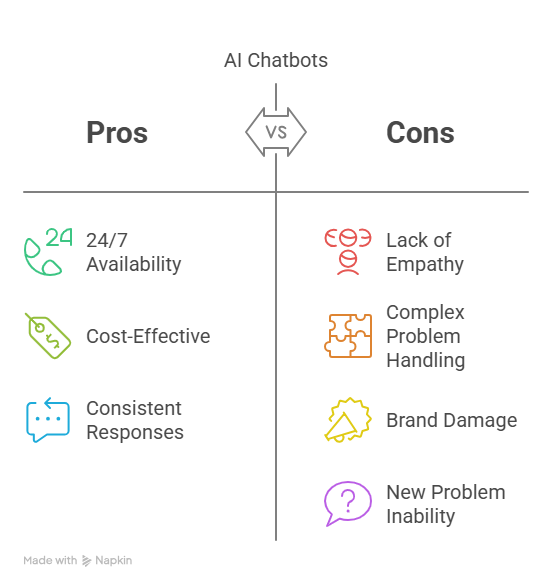
1. Lack of Empathy
Bots don’t understand emotions well. If a customer is angry or stressed, a generic or cheerful reply can make things worse.
Example: A user reports a critical bug. The bot replies, “Have you checked our FAQs?” This feels cold and dismissive. It can make the customer even angrier and damage trust.
2. Trouble with Complex Problems
Chatbots often fail when the issue is complicated. If the solution needs judgment, creativity, or knowledge that’s not documented, the bot will struggle.
By the time it hands things off to a human, the customer is already frustrated.
3. Bad Bot Experience Can Hurt Your Brand
When bots fail, it doesn’t just annoy customers, it can damage trust in your entire company. Unlike a human agent who might apologize or fix things on the spot, a bot that keeps looping or giving irrelevant answers feels cold and careless.
Example: A customer notices a billing error and tries to fix it through your chatbot. But instead of getting real help, the bot keeps repeating the same steps, “Please check your invoice in the billing section.”
After 30 minutes of going in circles, the bot ends with, “Glad I could help! Have a great day!”
Such experiences can really make a customer go away.
4. Can’t Handle Truly New Problems
Bots work best with known issues. When something new or unexpected comes up, they don’t know how to respond. Unlike humans, they can’t think on the spot or adjust in real-time.
Where Humans Still Win (And Why Their Skills Matter Most)
Great customer service still needs a human touch. Chatbots are fast, but humans bring empathy, flexibility, and judgment that you can’t replace.

1. Calming Down Angry Customers
Humans know how to listen, understand feelings, and de-escalate tense moments.
Example: When a frustrated customer complains, a human can say, “I totally get why you’re upset. I’ll stay on this until we fix it.” That kind of response builds trust.
Bots can fake sympathy, but they can’t truly connect or adjust to emotion in real time.
2. Fixing Problems That Don’t Fit the Script
Not every issue is simple. When the situation is messy or unclear, humans can ask smart questions, find patterns, and work across teams to get answers.
They can go beyond the rules when needed. Chatbots can’t do that. They stick to what they’re told.
3. Turning Problems into Opportunities
A good support rep can save a customer, and even make them more loyal.
Example: A customer wants to cancel. The Chatbot cancels it. Done.
But a human asks why. Maybe the customer misunderstood a feature or is worried about cost. The agent offers a solution like a better plan, a free trial, or some extra help.
This could make that customer stay and even improve their experience with your brand.
4. Spotting Problems Before They Happen
Skilled agents often notice patterns or signals before something breaks.
They might flag bugs, suggest product fixes, or guide a customer to avoid future issues. Where bots react, humans anticipate.
How Smart Companies Use AI and Humans Together
Top companies don’t choose between AI and people. They use both in one smooth system. Here’s how it works:
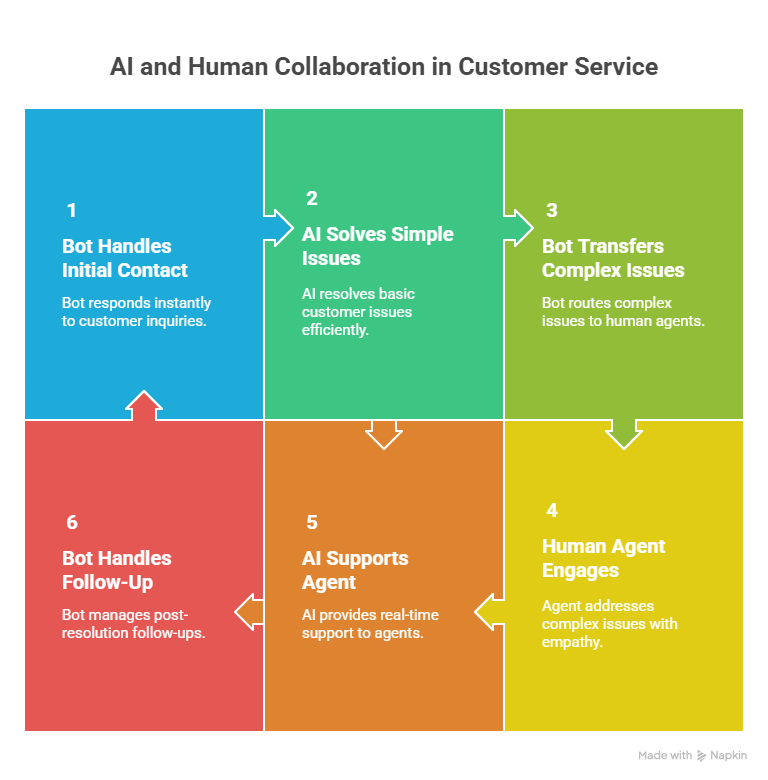
1. Bot Handles First Contact Automatically
When a customer reaches out through chat, app, or social, the bot replies instantly. It figures out what the customer needs and offers quick help for common questions.
2. AI Solves Simple Issues or Collects Key Info
For easy requests like “Where’s my order?”, the bot gives answers right away. If the issue is more complex, it collects important details like account info or previous steps taken.
3. Bot Sends Complex Issues to the Right Agent
If a human is needed or the customer sounds upset, the bot routes the chat to the best agent, based on skill, language, or availability.
4. Human Agent Joins with Full Chat History
The agent sees everything: what the bot said and what the customer shared. The customer doesn’t have to repeat anything. The agent focuses on solving the issue with empathy.
5. AI Supports the Agent in Real Time
While the agent chats, AI suggests useful info, like help articles, customer history, or next steps, so the agent can respond faster and better.
6. Bot Handles Follow-Up After Resolution
Once the problem is solved, the bot sends a survey, logs a summary, or follows up with the customer if needed.
As a result, you get quicker responses, fewer repetitive tasks for agents, and happier customers who feel heard and helped.
How to Know If You’re Ready for a Chatbot
Here are signs your business is ready for a bot:
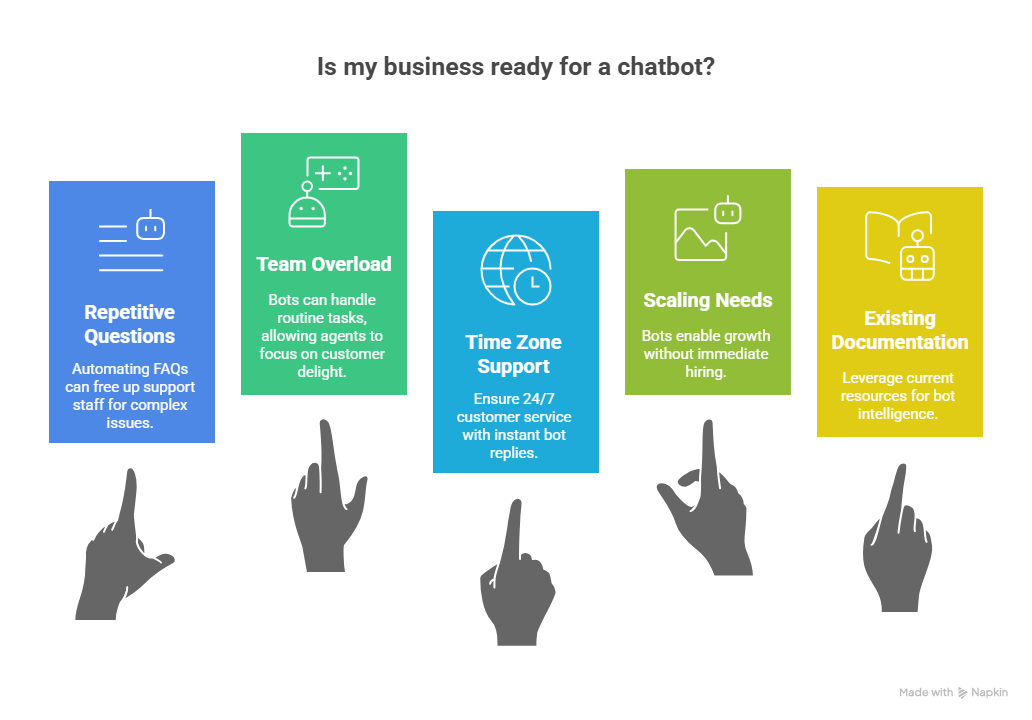
- You get too many repetitive questions. If 40%+ of your support tickets are simple FAQs (like WISMO, password reset, refund policy), that’s prime for automation.
- Your team is buried under low-value work. Agents are stuck answering the same questions instead of solving complex issues or delighting customers.
- You support customers across time zones. If you have late-night or international traffic, a bot ensures instant replies, even when your team is offline.
- You’re scaling fast. Whether it’s seasonal spikes, a new product launch, or rapid growth, bots let you scale without hiring more agents immediately.
- You already have support documentation. Chatbots are only as smart as their sources. If you’ve got a strong help center or FAQs, a bot can use it from day one.
If at least 3 of these match your situation, you’re ready to start testing bots.
Chatbot vs. Human vs. Hybrid: Quick Cost-Benefit Snapshot
Want to see the tradeoffs at a glance? Here’s a simple breakdown:
The hybrid model gives you speed and personalization. Bots handle the bulk. Humans jump in when it matters.
Are There Any Legal or Ethical Risks with Chatbots?
Yes, and you should take them seriously. Here’s what to keep in mind:

- Privacy: Never collect sensitive info, like payment details or personal ID, through chatbots unless your system is fully compliant.
- GDPR/CCPA: If you serve users in the EU or California, your chatbot must follow data rules. That means data access, deletion requests, and consent collection.
- Transparency: Always let users know they’re talking to a bot. Deception (even accidental) can erode trust quickly.
- Bias + Fairness: If your bot uses AI to recommend responses, test it for bias. Don’t train it only on a limited or skewed dataset.
Platforms like Lindy let you set data retention policies, add disclaimers, and build secure handoffs. But it’s your job to make sure your chatbot respects your users.
How to Choose the Right Chatbot Tool?
Not every chatbot platform is built the same. Before you commit, ask these questions:
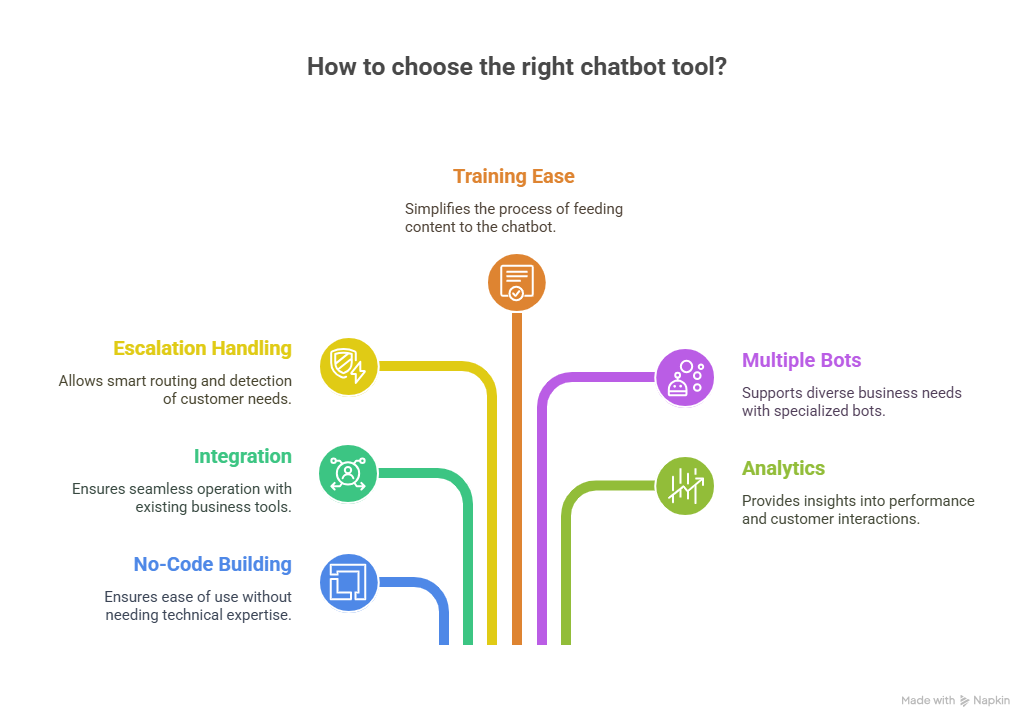
- Can I build it without code? You shouldn’t need an engineer just to launch an FAQ bot.
- Does it integrate with my stack? It should work with your CRM, helpdesk, Slack, and email tools out of the box.
- Can it handle escalations smartly? Look for keyword triggers, tone detection, or routing logic.
- Is it easy to train on my content? Feeding it FAQs, docs, and chat transcripts should be simple.
- Does it support multiple bots? You might need one for sales, one for support, and one for internal workflows.
- Is there analytics? You need insights: what’s working, where humans step in, and what customers are asking.
Bonus tip: Start with a free version or pilot. Test on one use case before expanding across the business.
Lindy Lets You Automate the Busywork & Focus on What Matters
If you want to mix bots and humans the right way, Lindy makes it easy — no coding needed.
Here’s what you can do with Lindy.
- Build AI agents in minutes: Train Lindy on your FAQs, help docs, and past conversations. It can handle most Tier 1 questions with speed and accuracy.
- Route tough cases to real people: Use smart rules to detect urgency, tone, or complexity. Lindy passes the conversation to a human when needed — no delays, no guesswork.
- Keep context across every tool: Lindy connects with your CRM, helpdesk, order systems, and internal docs. That way, both bots and humans always have the full picture.
- Track and improve performance: See which questions bots handle well and where humans do better. Use that data to fine-tune your support flow over time.
See how Lindy helps teams automate support without losing the human touch.
Way More Than Just Support
Lindy isn’t just for answering customer queries. It can also:
- Write content
- Generate website code
- Handle internal workflows
- And much more
Check out the full list of Lindy AI employee functions.
{{cta}}
Frequently Asked Questions
- Can bots fully replace human workers?
Bots are fantastic at handling routine and repetitive tasks, but fully replacing human workers is not really likely at this point. They can't replicate the emotional intelligence, creativity, or complex problem-solving that humans excel at. It isn’t about choosing one over the other — it's about finding a balance that works for your clients and your business.
- What tasks should never be given to a bot?
Jobs requiring empathy, critical thinking, and adaptability — like handling sensitive customer complaints or resolving hyper-complex issues — should always be reserved for humans. Bots can manage a lot, but human or not is the question when the situation needs a personal touch.
- How much can businesses save by using bots over humans?
Businesses can significantly cut costs by using bots for high-volume, low-complexity tasks, e.g., FAQs, email management, and data entry. Bots work 24/7, cutting down the need for overtime while allowing humans to focus on higher-value tasks.
- When exactly should I use a chatbot vs. a human agent?
Use chatbots for handling repetitive, high-volume tasks like order tracking, FAQs, or appointment confirmations. Use humans when the situation calls for empathy, negotiation, creative problem-solving, or handling edge cases. If a question is simple and predictable, use a bot. If it’s complex or emotional, use a human.
- How do I make the transition from bot to human seamless?
Ensure your chatbot collects key context (e.g., customer name, issue, conversation history) before escalating. That data should be instantly passed to the human agent. Make the transition seamless so the agent gets full context, and the customer never has to repeat themselves. With tools like Lindy, you can automate this handoff with no repetition or downtime for the customer.
- What’s the biggest risk of over-relying on bots?
Customers may feel like they’re talking to a wall if your bot can’t recognize its limits or escalate properly. Poor handoffs and generic responses hurt trust. Always build in a fallback to a human, especially for refunds, complaints, or emotional support issues.
- How can I tell if my chatbot is doing a good job?
Track metrics like response time, resolution rate, handoff rate to humans, and CSAT (Customer Satisfaction Score). If your bot solves routine issues quickly and escalates complex ones cleanly, it’s working. High handoff rates or repeat customer contacts could be red flags.
- Can bots handle personalized customer service?
Yes, if your bot is integrated with your CRM or customer data platform. Lindy, for example, can pull in customer history, previous orders, and preferences to tailor responses. But personalization is still limited by how well the bot is trained.
- Is using both bots and humans more expensive than just hiring staff?
Not if it’s done right. Bots handle scale efficiently and reduce the number of full-time agents you need for repetitive work. Humans are used strategically for edge cases, making your team leaner and more cost-effective long term. Lindy helps with both ends.
- What if my team doesn’t have technical expertise to build chatbots?
Use a no-code tool like Lindy. You can build and launch smart AI agents without writing code. Just define workflows, connect your apps, and hit deploy. It’s designed for business teams, not engineers.
- What industries benefit most from bot + human support?
E-commerce, SaaS, healthcare, travel, finance, and customer service-heavy businesses benefit the most. Any industry with a high volume of customer interactions, routine requests, or appointment-based services can see major gains from automation with human support.
- Can bots handle live chat, email, and back-office tasks at once?
Yes. With a platform like Lindy, you can create multiple AI agents to handle live chat, draft and organize emails, manage CRM updates, assign tasks, and more — all simultaneously. Each agent can be task-specific, giving you 24/7 multitasking without hiring more people.
- How do I get started with building a bot-human workflow using Lindy?
Start by identifying the top 5 repeat tasks or questions your team handles. Use Lindy to build a chatbot that automates those. Then define clear escalation paths for when humans need to step in. Connect Lindy to your CRM, Slack, or help desk system. You can launch your first AI assistant for free.
- What should I do if the chatbot gives a wrong or frustrating response?
Don’t leave your customers hanging. Always add a clear fallback option to talk to a human. Also, review bot transcripts regularly and retrain it using real conversations. Tools like Lindy let you tag bad responses and refine answers over time.
- How do I avoid chatbot loops and repeated answers?
Use smart routing. A good bot should recognize when it’s stuck and pass the chat to a human. Also, set a “max tries” limit so it doesn’t keep repeating itself endlessly.
- Can chatbots damage customer trust if they fail?
Yes. A bad bot experience can frustrate users and hurt your brand image. Always disclose when a chatbot is replying, and make escalation fast. The longer the loop, the faster the user churn.



















.jpg)
.png)
.png)

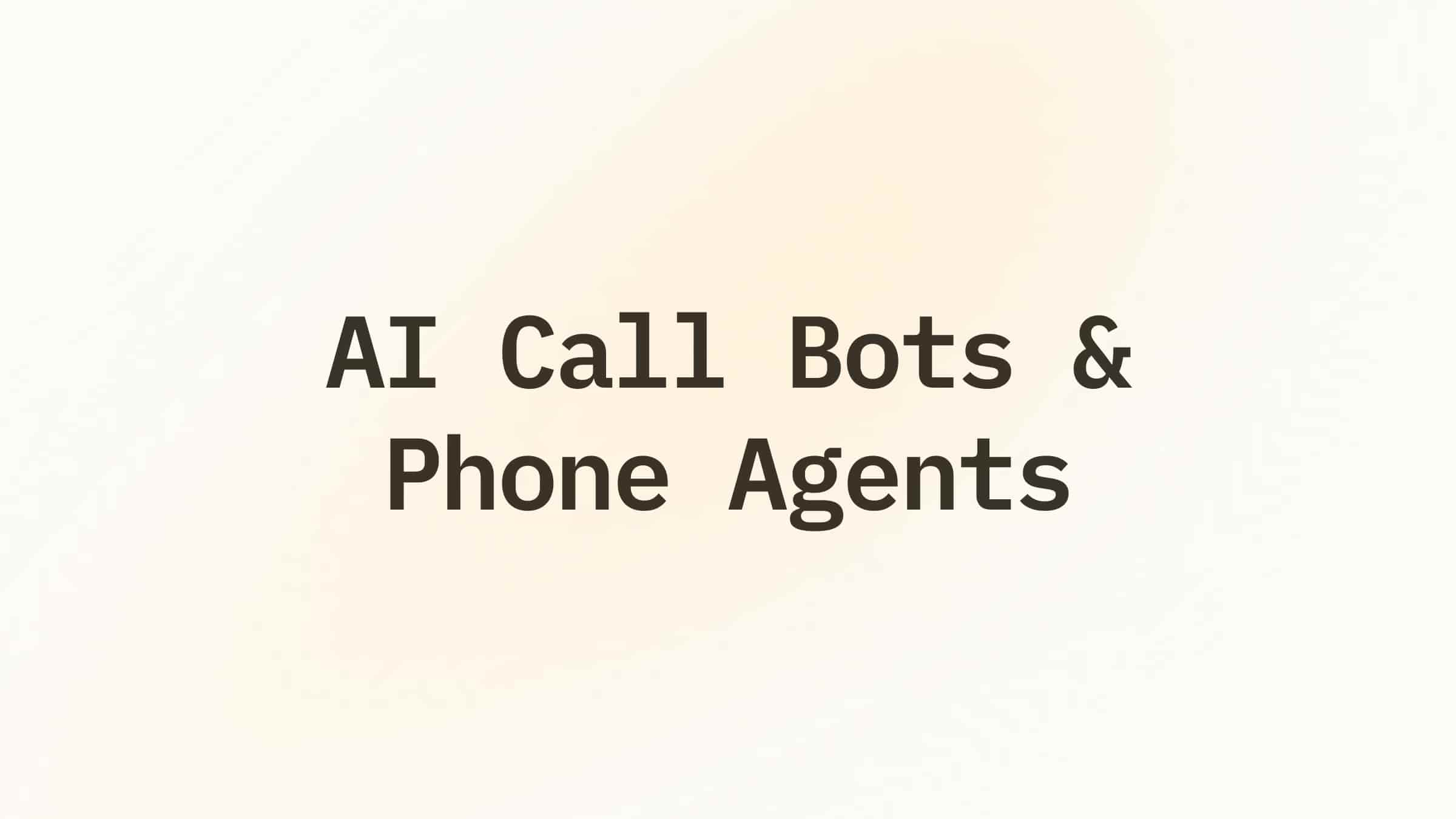
.png)
.png)